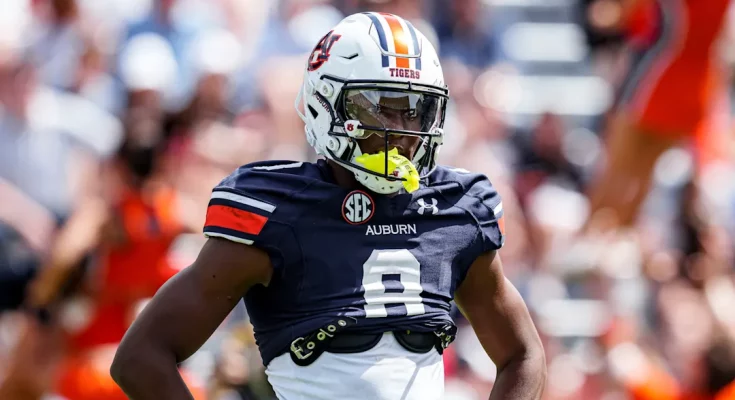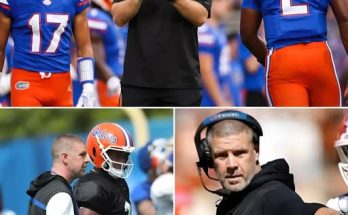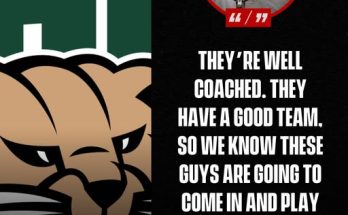Pro Football Focus apparently agrees, the Auburn Tigers have the best wide receiver room in the country, and the declaration is not just a statement to stir conversation; it is backed by data, deep analysis, scouting reports, and the kind of thorough breakdown that PFF has built its reputation on. The Tigers, long known for their rugged running game, explosive defensive fronts, and hard-nosed style of play, are suddenly being celebrated for their aerial arsenal. For years, Auburn fans had clamored for a more dynamic passing attack, something to rival the flashy offenses of SEC juggernauts like Alabama and LSU. Now, in a turn of events that feels both refreshing and overdue, the Tigers are being talked about as the program with the deepest, most versatile, and most talented group of wideouts in the nation. It is a narrative that is not just capturing the imagination of Auburn’s fanbase but is resonating across the college football landscape.
The conversation began to shift late last season, as Auburn’s receivers quietly started to dominate in matchups against some of the top defenses in the country. While the Tigers’ overall season record might not have reflected a national championship-caliber team, the flashes from their receiving corps told another story—a story of untapped potential that was just waiting for the right moment to explode. With offseason workouts, spring games, and training camps now providing more evidence, it has become impossible to ignore the fact that this unit is loaded from top to bottom. The combination of speed, size, route-running precision, and sheer playmaking ability is unlike anything Auburn has seen in decades.
What sets this wide receiver room apart from others around the country is not just the talent at the top, but the incredible depth that allows Auburn to rotate multiple players without any noticeable drop-off in production. Teams like Ohio State, Alabama, and USC have historically been considered the gold standard when it comes to receiver talent, with first-round NFL picks lining their depth charts. However, PFF’s recent analysis suggests that Auburn has managed to assemble a group that rivals, and possibly surpasses, these programs. That is a bold claim, but when you look at the Tigers’ roster, the evidence is compelling. There are players who can burn you deep, players who can make contested catches over the middle, and players who can take a five-yard slant and turn it into a sixty-yard touchdown with electrifying yards-after-catch ability.
One of the main catalysts for this transformation has been the recruiting strategy implemented by Auburn’s coaching staff over the past few years. Recognizing that the modern college football game is increasingly driven by high-octane passing attacks, the Tigers placed a renewed emphasis on securing elite receiver talent. They went after big names on the recruiting trail, flipped a few prospects who were initially leaning toward rival programs, and supplemented their roster with transfers who brought both experience and production. The result is a room that features a blend of young, explosive freshmen and seasoned veterans who know how to win matchups against top-level defensive backs. It is this mixture of youthful energy and veteran savvy that gives Auburn such a unique edge.
PFF’s grading system, which evaluates every snap, every route, and every target, has consistently ranked Auburn’s receivers near the top over the last few months. In particular, the Tigers’ ability to generate separation and make contested catches has been a defining characteristic. One statistic that stands out is their catch rate on passes thrown 20 yards or more downfield, which ranks among the highest in the nation. That ability to stretch defenses vertically forces opposing coordinators to adjust their game plans, often leaving other areas of the field vulnerable. Auburn’s receivers are not just one-dimensional deep threats, however. They excel at the short and intermediate routes as well, making them a nightmare to defend because they can beat you in so many different ways.
The star power at the top of Auburn’s depth chart is undeniable. Names like Ja’Varrius Johnson, Camden Brown, and Jay Fair have become synonymous with big plays and highlight-reel moments. Johnson, with his blazing speed and sharp route-running, is the kind of receiver who can take the top off a defense in an instant. He has the ability to turn a routine play into a game-changing moment, and his chemistry with the Tigers’ quarterbacks is evident every time they take the field. Brown, on the other hand, brings a physical presence that allows him to excel in contested-catch situations. He is the type of receiver who thrives in the red zone, where his size and strength give him a clear advantage over smaller defensive backs. Then there is Jay Fair, a versatile playmaker who can line up both inside and outside, creating mismatches no matter where he is on the field.
Beyond the headliners, Auburn’s depth is truly remarkable. Players like Omari Kelly, Landen King, and transfer additions from powerhouse programs have added layers of complexity to Auburn’s passing attack. Kelly is a name that has been generating buzz thanks to his ability to make acrobatic catches and his knack for finding soft spots in zone coverage. King, originally recruited as a tight end, has transitioned into a hybrid receiver role that makes him a matchup nightmare for linebackers and safeties. His size and catch radius make him a valuable weapon on third downs and in crucial moments. The addition of transfers who bring both experience and fresh perspectives has only strengthened this group, giving Auburn a level of depth that few teams can match.
It’s not just the raw talent that has elevated Auburn’s receivers to this elite status, but also the development and coaching they have received. Wide receivers coach Marcus Davis has been instrumental in refining the skills of this group, focusing on the finer details of route running, footwork, and timing. Under his guidance, Auburn’s receivers have become not just athletes, but technicians who understand the nuances of their craft. This attention to detail is evident in the way they create separation, the precision of their cuts, and their ability to adjust to balls in the air. Davis’s influence cannot be overstated; he has turned a talented group of players into a cohesive unit that operates with a level of polish typically seen in top NFL teams.
Another factor that has contributed to Auburn’s rise is the improved quarterback play. While this article focuses on the receivers, it’s impossible to ignore the synergy between the pass catchers and the quarterbacks delivering the football. Auburn’s passing game has evolved to feature more timing routes, back-shoulder throws, and deep shots that showcase the strengths of their wideouts. The quarterbacks have shown trust in their receivers to make plays even when tightly covered, and that trust has been rewarded time and time again. The combination of accurate throws and receivers who can win one-on-one battles has made Auburn’s passing attack far more dangerous than it has been in recent memory.
Recruiting analysts have taken notice of Auburn’s surge in wide receiver talent, and so have NFL scouts. During Auburn’s pro days and practices, scouts have been particularly focused on the receiver drills, noting the explosiveness, hands, and body control of this group. Several Auburn receivers are already being projected as high NFL draft picks, and that pipeline of professional talent further reinforces the idea that this is not just a one-year fluke, but the beginning of a sustained run of excellence at the position. When a program can consistently produce NFL-caliber receivers, it not only boosts the team’s success on the field but also attracts future recruits who want to follow in those footsteps.
For Auburn fans, this recognition from Pro Football Focus is a point of pride. It represents a validation of the program’s efforts to modernize its offense and compete at the highest level. The SEC is a conference loaded with talent, and for Auburn to be considered the best in any offensive category is no small feat. It speaks to the hard work of the coaching staff, the dedication of the players, and the vision of a program that refuses to settle for mediocrity. While Alabama’s dominance has often overshadowed Auburn in the state’s football narrative, the Tigers’ emergence as a receiver powerhouse is a reminder that Auburn is more than capable of stealing the spotlight.
The road ahead for Auburn’s receivers is both challenging and exciting. The upcoming season features matchups against some of the toughest defenses in the nation, including SEC powerhouses with elite secondaries. These games will provide the ultimate test for Auburn’s receivers, allowing them to prove that their accolades are not just preseason hype but are backed up by performance on the biggest stages. PFF’s ranking may have put a target on their backs, but this group appears more than ready to embrace the challenge. In fact, many of Auburn’s players have expressed that they thrive under pressure and relish the opportunity to show why they are considered the best.
The chemistry between Auburn’s receivers is another underrated factor in their success. While individual talent is crucial, football is a team sport, and the ability of these players to work together, block for each other, and create opportunities for one another cannot be overlooked. Watching Auburn’s receivers in practice or games, you can see the camaraderie and unselfishness that defines this group. Whether it’s one receiver clearing out a defender with a deep route to open space for a teammate underneath or another throwing a key block on a screen pass, these players understand that success comes from collective effort. That chemistry, combined with their talent, is a big reason why Auburn’s receiver room is being hailed as the best in the nation.
The analytics from PFF go beyond just catch rates and yards. They look at advanced metrics like yards per route run, separation percentage, contested catch rate, and even blocking grades. Auburn’s receivers excel across the board, which is rare. Often, a team might have one or two star receivers who dominate the stats while the rest of the group lags behind. Auburn, however, has managed to maintain a high standard across its entire depth chart. This balance makes it difficult for opposing defenses to key in on just one player, as any of Auburn’s receivers can step up and make a big play at any time.
Even Auburn’s younger players have been making noise. Freshmen like Malcolm Simmons have shown flashes of brilliance in practices and scrimmages, suggesting that Auburn’s dominance at the receiver position is not just a current trend but something that could last for years. Simmons, in particular, has drawn comparisons to some of the SEC’s all-time great receivers due to his combination of speed, agility, and hands. When you can bring in a freshman who can immediately contribute, it speaks volumes about the quality of your recruiting and the culture of your program.
The Auburn Tigers’ offensive playbook has also evolved to maximize the strengths of their receivers. Offensive coordinator Philip Montgomery has introduced more creative route combinations, motion packages, and tempo variations designed to put defenses on their heels. These adjustments have opened up opportunities for Auburn’s receivers to exploit mismatches and make explosive plays. By using pre-snap motion and bunch formations, Auburn has been able to create confusion among defensive backs, often leading to wide-open looks downfield. The receivers have embraced these schemes, showing a high football IQ and the ability to adjust on the fly.



